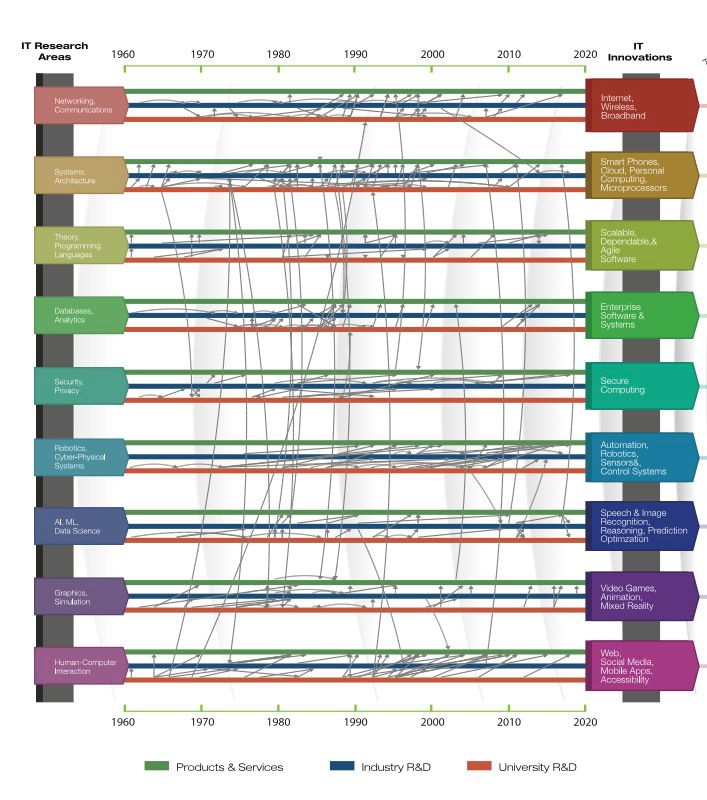
“Numerous technologies that we rely on in our daily lives have roots in long-term federally funded frontier research,” says Microsoft chief scientific officer and 2015 ACM AAAI Allen Newell Award recipient Eric Horvitz. “It’s interesting and illuminating to follow lines of innovation across time to develop understandings of the rich interrelationships among federally funded research and corporate R&D efforts,” says Horvitz.
To that end, a new report from the National Academies of Sciences, Engineering, and Medicine links investments in federally funded research to their economic payoff in both the Information Technology (IT) sector and throughout the U.S. economy.
The report, entitled Information Technology Innovation Resurgence, Confluence, and Continuing Impact, is the latest in a series that has analyzed the impact and results of federal investments in technology since the mid-1990s. The latest iteration includes numerous examples of the impact of federally funded IT research programs, while also depicting the growing role IT innovation has on vital aspects of the U.S. economy.
Said Elizabeth Mynatt, Regents Professor at the Georgia Institute of Technology (Georgia Tech) and chair of the Committee on Depicting Innovation in IT that authored the National Academies report, “The primary message historically was that many technology companies, the Googles of the world, didn’t just pop up out of garages. ” Mynatt emphasized that the roots of many such technology companies can be tracked back to a long tradition of federally funded academic research.
“This latest report reflects the continuing evolution of the research,” notes Jon Eisenberg, staff director of the Computer Science and Telecommunications Board (CSTB) at the National Academies.
Eisenberg said, “We identified two patterns that are talked about the report, Resurgence and Confluence, and we decided that it was time to tell the story of how these research advances that were fueling the computing industry were also fueling advances more broadly in the economy. That’s obviously something that’s been happening for a long time.”
The Confluence section of the report provides examples of IT innovations combined with deep domain expertise, design and production knowledge, and new business models to create transformative results across the U.S. economy. Narratives around healthcare, the automotive industry, agriculture, and even sports, point to a substantial history of IT innovation spurring entirely new capabilities, ultimately resulting in safer cars, saved lives, more sustainable food production, and more sophisticated sports training and fan experiences.
The Resurgence section provides examples of funding and research interests falling off in areas in which progress has slowed, to be followed by a resurgence in interest and activity years or even decades later. Resurgence covers areas such as virtualization, artificial intelligence, machine learning, natural language processing, computer vision, and neural networks, among other examples.
Eisenberg said that, while the entire computing community could not be represented in the report, a wide-ranging group of individuals that sampled the space well was assembled as contributors. “We had several information gathering sessions where people came in and talked to us about various research area perspectives, as well as application areas, whether it was the automotive industry or healthcare, for example,” he said, noting that a panel focused on AI was convened because there was a particularly rich set of stories around the topic that were very timely, and these stories represented powerful examples of the Resurgence phenomenon.
Tom Mitchell, E. Fredkin University Professor in the Machine Learning Department of the School of Computer Science at Carnegie Mellon University and a member of the National Academy of Engineering, served as the chair of the AI Panel that produced the AI Resurgence section of the report. Mitchell said the point of the study is to understand what kind of return on investment (ROI) the U.S. has received from investing in very fundamental IT research and computer science.
“To cut to the chase,” Mitchell said, “the answer is, it’s a ridiculous return on investment.”
The report provides an idea of how large that return on investment has been. The report cites estimates by the U.S. Bureau of Economic Analysis that show the IT-intensive “information- communications-technology-producing (ICT)” industries grew 52% from 2012 to 2018, and contributed nearly 6.2% (over $2.2 trillion) to overall U.S. gross domestic product (GDP) in 2018.
For perspective, total federal funding for the networking and IT research and development (R&D) program, which includes most federal support for IT R&D, reached about $5.1 billion, or 0.03% of GDP, in fiscal year 2018.
Tire Tracks
The initial report in this series, Evolving the High Performance Computing and Communications Initiative to Support the Nation’s Information Infrastructure, was released in 1995. A graphic in the report, often called the “tire tracks” diagram because of its appearance, illustrated how federal research investments in IT ultimately led to billion-dollar tech industries and has repeatedly produced practical technologies that have impacted everyday life.

“A version of the ‘tire tracks’ has appeared in every one of these reports over the years showing a table breaking computer science down into different areas and seeing where and when different spinoffs happened that led to huge companies like Oracle, Intel, Apple, or Google,” Mitchell says. “So, it is ‘tire tracks’ in the sense that you look back and see where this all came from.”
Says Mynatt, “I think if you would summarize the first version of the ‘tire tracks’ argument, it was to convince congressional staffers that these companies didn’t appear by magic. The continued investment in computing research was really important.”
The primary purpose of the current report was to update the “tire tracks” table from the previous report in the series, Continuing Innovation in Information Technology, published in 2012.
As chair of the Committee that produced the current report, Mynatt says the first phase of the work was to ask how the world has changed since 2012. In going through that reflective process, she says, the perspective of the report moved quite a bit.
“When you look at where information technology makes a difference—in healthcare, in the cars we drive, how we shop online—that’s how you know so much of a daily life is now reliant on these innovations,” Mynatt says. She added that it seemed shortsighted to just tell the story that IT companies emerged as a result of federally funded research.
Horvitz also had contributed to the AI tire tracks included in the 2012 report, and found it intriguing to be involved in both reports — and to build on the prior effort.
“To get to the inflection point we’re at now with AI, it took persistent and patient funding by federal agencies over many decades,” he said.
Horvitz added that federal support carried the research community through multiple paradigms and waves of innovation, with significant confluences and resurgences across time and across methodologies.
Said Mitchell, “You have to do this kind of high-risk, fundamental work if you’re going to have fundamental advances.” He feels the real importance of these reports is that they document IT is indeed a great investment for the U.S.
“It’s important to note is this is not just about the past; it continues to be a great investment.”
John Delaney is a freelance writer based in New York, NY, USA



Join the Discussion (0)
Become a Member or Sign In to Post a Comment